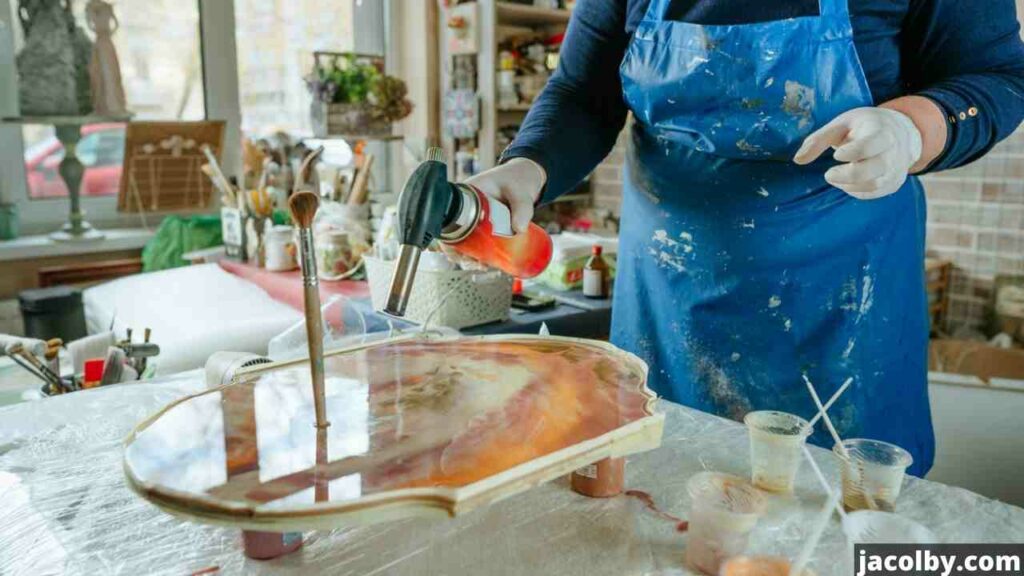
Combining wood and epoxy resin to make beautiful furniture and artwork is becoming more popular in the world of do-it-yourself projects.
There are many methods to utilize epoxy resin for wood. For example, you may use it as a transparent coating to improve the beauty of a wooden surface, or you can use it to create full pieces of furniture out of wood and resin.
This article will walk you through the basics of woodworking epoxy and provide step-by-step instructions on how to use it.
Do you feel the desire to decorate your house with your wooden epoxy decor? I agree. Therefore, let’s start on the adventure of making something amazing out of our talents.
If you are just getting started, it’s possible that you don’t know much about the science behind epoxy. Won’t bore you with details. Instead, I’ll concentrate on a few easy tips for epoxy resin pours in woodworking.
Now that I have showered your mind with the exotic epoxy resin holds then, let me equip you with the supplies and the preparations before you come up with your masterpiece
Table of Contents
Supplies and preparations that are necessary –
1. Wooden art panel with a size of 12 x 12 inches
2. Epoxy resin(Have a look at these epoxy resins for wood with supreme quality)
3. A pair of gloves made of nitrile, a stir stick, and a spreader.
4. A rung up the ladder
5. Unambiguous measurement markings on a measuring cup
6. Container for mixing
7. A portable torch
8. Toothpicks
9. Safeguard your work from damage while it dries in an empty plastic bag or cardboard box
After acquiring the essential materials, let’s get our hands dirty and build our masterpiece using epoxy resin for wood.
1. Incorporating Epoxy Resin –

The first step is to fill a measuring cup with resin. Measure out your hardener and pour it evenly into the second container to ensure even distribution.
To avoid a gummy cure, I like to fill the hardener a little more than the resin, according to my experience.
Pour Resin from the Measuring Cup containing Resin into a clear mixing cup with the help of the Craft Stick. Scrape the cup’s sides and allow enough time for the Resin to “ooze” out of the cup.
Spoon the Hardener into the Measuring Cup, and then pour the Clear Mixing Cup over the top of it. Scrape the measuring cup’s walls to ensure that the hardener is well incorporated into the Mixing Cup before adding it to the recipe.
MIX WELL That’s the rule: Stir Epoxy Resin for 5 minutes. Rotate your strokes clockwise, counterclockwise, up-and-down, and across. Changing your blending pattern ensures a complete blend.
When you’re done mixing, ensure you’ve scraped the sides and bottom of the container well. This prevents material from clumping on cup sides. The epoxy should get hazy as you mix it. Examine the epoxy glue for bubbles.
2. The Stage of immersing the epoxy resin down –
This step is majorly concerned with dealing with cracks, voids, and splits; thus, it needs maximum concentration and holds maximal importance.
Due to changes in the wood cell structure, cracks and splits are formed during drying. You can ensure the wood won’t deteriorate by putting epoxy to fractures and splits.
To fill cracks and splits, apply epoxy to the shallowest part of the crack and let it run down. This lets air escape from the crack and reduces the likelihood of epoxy air bubbles.
Several droplets of epoxy should fit on your craft stick. Slowly drip them into fissures. Void spaces may be left behind by deterioration, branch collars, or bugs that tunnel into the wood.
A bottom-up filling is ideal. Choose a point in the vacuum and drip epoxy in. Letting the epoxy soak into the void may prevent trapped air bubbles.
Depending on the void, pour straight from the cup. If you do this, pour slowly. Simply putting in epoxy without allowing it to permeate into the wood and settle can result in entrapped air bubbles.
3. Undergoing the Curing Process –

After applying epoxy, heat the void. Make sure you use a heat gun with many heat and fan settings. I’ve seen others cure epoxy using a butane flame or hair dryer.
Since I haven’t tried them, I can’t recommend them. I prefer having a heat gun that is on medium with a slow fan. Once Start up the heat gun approximately a quarter of a minute before you need to use it.
This warms it up. Now I’ll pop bubbles. By hovering the Heat Gun over the epoxy, the bubbles should dissipate. Heat the epoxy every five minutes for 40 minutes after mixing. Avoid heat gun fan sloshing’.
If you are not cautious, it will sometimes force liquid epoxy into areas where you did not want it to go—nearly done! As the wood collects epoxy, your pour levels will drop.
While applying heat, make sure fills stay above the board. Epoxy as required. Some voids absorb epoxy more than others. Depends on wood porosity and epoxy surface area.
What to Keep in Mind When Working with Wood and Resin?
When dealing with wood and resin, it is essential to remember that most woods will change size in response to the temperature and humidity of their surroundings.
This is something that should be kept in mind at all times. As a result, the volume of the wood will shift ever-so-slightly, potentially creating problems for components that are secured with epoxy glue.
Keep the following things in mind before you work with wood and epoxy resin-
1. For wood restorations, use a low-viscosity resin that can cover even the tiniest cracks and cavities.
2. Pouring resin into a casting mold is a snap with low-viscosity resins.
3. If you merely want to cover your wood in a transparent layer of protection, use a resin with a relatively high viscosity.

4. It’s important to know whether your epoxy is intended for indoor or outdoor usage since outdoor epoxy must be UV-resistant to avoid withering and discoloration.
5. To ensure the safety of your lungs, use a respirator and keep your room well-ventilated. A respirator will protect your lungs from the resin fumes.
6. If resin comes into contact with your skin, wash it off immediately with plenty of water.
7. Use defined tools that may only be used on resin
8. Follow the directions for mixing on your resin container.
FAQs –
How exactly does one go about degassing bubbles in epoxy resin?
Wait ten minutes before stirring the epoxy to give the air bubbles time to rise to the top. To eliminate bubbles, apply heat to the surface from a distance of 6 to 8 inches using a heat gun or a propane torch and work in a back and forth motion.
Avoid overheating the epoxy since this might cause it to scorch or catch fire. Check for more bubbles at regular intervals and remove them as necessary.
Does epoxy resin have the potential to alter the color of wood?
When exposed to moisture, bare wood will often take on a somewhat more saturated hue.
Although the degree to which the color changes may vary depending on the kind of wood, one useful analogy is the difference in change between wet and dry wood.
When in doubt, do a test on a smaller scale to confirm that the level of color saturation meets your expectations.
How exactly does one clean or remove epoxy resin off surfaces and tools?
Warm water that has been soap-treated is an effective hardener. When working with resins, denatured alcohol, isopropyl alcohol, or acetone are all effective solvents.
First, it is best to use some rags to remove as much of the material as possible by soaking it up and/or scraping it off, and then you should clean the damaged areas using one of the solutions given above.
Solvents will no longer be effective in removing cured material. It has to be sanded down.
Conclusion –
Now that I’ve given you an overview of the steps, you need to start! Then get on the train and unleash your creative side by working with epoxy glue on wood, but before you do so, make sure you pay careful attention to the rules and restrictions that are provided.